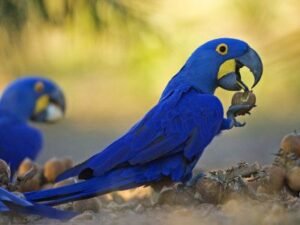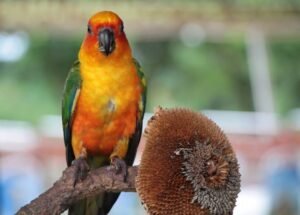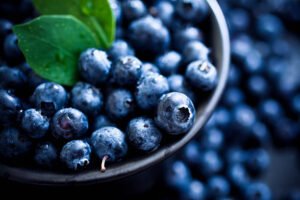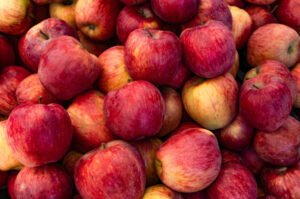
The Blue Parrot, a captivating and vibrant species known for its stunning azure plumage and lively personality, has specific dietary preferences contributing to its overall well-being and distinctive appearance. In this exploration, we delve into the culinary inclinations of these enchanting creatures, uncovering the top five favorite foods that not only cater to their nutritional needs but also satiate their discerning palates.
At the heart of the Blue Parrot’s diet lies a selection of fruits that mirror the vibrant hues of their feathers. From succulent blueberries to tropical delights like papayas and mangoes, these feathered connoisseurs have a penchant for the sweet and juicy. Beyond fruits, nuts play a crucial role in providing essential fats and proteins, with almonds and walnuts ranking high on the list of their preferred snacks.
Intriguingly, the Blue Parrot also exhibits a refined taste for leafy greens, showcasing a sophisticated palate that includes kale, spinach, and Swiss chard. These nutrient-rich greens contribute to their overall health and add a burst of color to their daily culinary repertoire. Additionally, grains like quinoa and brown rice appear, offering a wholesome and hearty component to their meals.
As we unravel the culinary tapestry of the Blue Parrot, it becomes evident that their dietary preferences are not just a matter of sustenance but a symphony of flavors, textures, and nutritional balance. Join us on this gastronomic journey as we explore the exquisite world of the Blue Parrot’s five favorite foods, unraveling the secrets behind their vibrant plumage and thriving vitality.
Almonds
Including almonds in the Blue Parrot’s diet is not merely a gustatory indulgence but a strategic choice rooted in the nutritional benefits these nuts offer. Almonds are renowned for being a powerhouse of essential nutrients. When incorporated into the diet of Blue Parrots, they contribute significantly to the overall health and well-being of these vibrant avian companions.

First and foremost, almonds are rich in healthy fats, mainly monounsaturated fats. These fats are crucial in providing a sustainable energy source for Blue Parrots, supporting their daily activities and ensuring they maintain optimal energy levels. Furthermore, omega-3 fatty acids in almonds contribute to the development and maintenance of the Blue Parrot’s plumage, ensuring that their distinctive azure feathers remain vibrant and lustrous.
Beyond their fat content, almonds are a remarkable source of protein, a fundamental building block for muscle development and maintenance. The protein content in almonds assists Blue Parrots in maintaining their muscle mass, facilitating proper growth, and aiding in the recovery from physical exertion. This is particularly important for parrots that engage in active behaviors such as flying and playing, as it helps them maintain a robust physique.
Almonds also boast an impressive array of vitamins and minerals, enhancing their nutritional profile. Blue Parrots benefit from the vitamin E found in almonds, which acts as a potent antioxidant, safeguarding their cells from oxidative stress and contributing to a strengthened immune system. Additionally, almonds provide essential minerals like magnesium and phosphorus, supporting bone health and ensuring the structural integrity of the Blue Parrot’s skeleton.
Interestingly, almonds serve as a natural source of dietary fiber, promoting digestive health in Blue Parrots. The fiber content aids in proper digestion, preventing constipation, and promoting a healthy gut microbiome. A well-functioning digestive system is crucial for the absorption of nutrients, ensuring that the Blue Parrot derives maximum benefit from the diverse array of foods in its diet.
To incorporate almonds into the Blue Parrot’s diet effectively, it is essential to offer them in moderation. Almonds can be provided as whole nuts or crushed into smaller pieces, allowing for easy consumption. The shells of almonds should be removed to prevent any potential hazards, and it’s advisable to introduce almonds gradually into the parrot’s diet to observe their reaction and ensure they adapt well to this nutritious addition.
Almonds stand out as a nutritional powerhouse for Blue Parrots, offering a spectrum of health benefits contributing to their overall vitality. From providing essential fats for energy to supporting feather health and bolstering the immune system, almonds play a pivotal role in enhancing the well-being of these enchanting avian companions. As responsible caretakers, understanding the significance of almonds in the Blue Parrot’s diet empowers us to provide a balanced and enriching culinary experience, ensuring that these majestic birds thrive in captivity.
Sunflower Seeds
Sunflower seeds emerge as a delectable and nutrient-rich addition to the Blue Parrot’s culinary repertoire. Beyond being a flavorful treat, these seeds offer myriad health benefits, contributing to the overall well-being and vibrancy of these captivating avian companions. Their rich content of healthy fats is at the core of sunflower seeds’ nutritional allure. Like many birds, Blue Parrots benefit significantly from a diet that includes sufficient healthy fats, and sunflower seeds provide an excellent source of these essential nutrients. The omega-6 fatty acids found in sunflower seeds play a pivotal role in supporting the Blue Parrot’s cardiovascular health, ensuring proper heart and circulatory system functioning.

In addition to healthy fats, sunflower seeds are a concentrated source of protein, a critical component for the Blue Parrot’s muscle development and maintenance. Protein is especially vital for parrots engaged in energetic activities such as flying and climbing, as it aids in repairing tissues and building solid and resilient muscles. Including sunflower seeds in the diet ensures that Blue Parrots receive a well-rounded source of amino acids, the building blocks of protein.
Sunflower seeds are also rich in essential vitamins and minerals that contribute to the holistic health of Blue Parrots. Vitamin E, a potent antioxidant in these seeds, supports the immune system, shielding the birds from oxidative stress and bolstering their ability to fend off infections. Additionally, sunflower seeds provide vital minerals such as magnesium and phosphorus, promoting bone health and ensuring the structural integrity of the Blue Parrot’s skeletal system.
Furthermore, sunflower seeds contain dietary fiber, which is crucial for digestive health. Proper digestion is essential for the absorption of nutrients, and the fiber content in sunflower seeds aids in regulating the Blue Parrot’s digestive processes. This, in turn, helps prevent issues like constipation and ensures a healthy gut microbiome, promoting overall gastrointestinal well-being.
When incorporating sunflower seeds into the Blue Parrot’s diet, it is essential to do so in moderation. While these seeds offer numerous benefits, an excess can lead to an imbalance in the bird’s diet. Combining sunflower seeds with other sources and nuts is advisable, creating a diverse and nutritionally complete offering for the parrot. Offering sunflower seeds as a part of the Blue Parrot’s foraging experience can also stimulate their cognitive abilities and prevent boredom. Encouraging natural behaviors such as cracking open seeds provides mental stimulation and mimics the activities they would engage in while foraging in the wild.
Sunflower seeds are a nutrient-rich delight for Blue Parrots, offering a spectrum of essential nutrients contributing to their overall health and vitality. As caretakers, incorporating these seeds into the parrot’s diet with consideration for moderation and variety ensures a well-rounded and enriching culinary experience. By understanding the nutritional benefits of sunflower seeds, we can actively contribute to the thriving well-being of these magnificent avian companions, fostering a life of vibrancy and joy in captivity.
Blueberries
In the intricate tapestry of the Blue Parrot’s diet, blueberries emerge as nature’s tiny treasures, providing a burst of flavor and a plethora of health benefits. These small, indigo-hued gems are not just a treat for the palate; they are a nutritional powerhouse that contributes significantly to the overall well-being of these captivating avian companions.

One of the primary reasons blueberries hold a special place in the Blue Parrot’s diet is their rich antioxidant content. Blueberries are renowned for being packed with anthocyanins, a compound class that gives them their deep blue color and offers potent antioxidant properties. These antioxidants are crucial in neutralizing free radicals within the Blue Parrot’s body, safeguarding their cells from oxidative damage and supporting a robust immune system.
Beyond their antioxidant prowess, blueberries are a rich source of essential vitamins. Vitamin C in these tiny fruits is particularly noteworthy, as it contributes to synthesizing collagen, a protein necessary for maintaining the integrity of the Blue Parrot’s skin, feathers, and connective tissues. Vitamin K, another vital nutrient found in blueberries, supports proper blood clotting and bone health, ensuring the overall structural soundness of the parrot.
Blueberries also bring dietary fiber to the Blue Parrot’s culinary experience. Thread is instrumental in maintaining digestive health, aiding in regular bowel movements, and preventing constipation. The fiber content in blueberries contributes to a healthy gut microbiome, fostering the growth of beneficial bacteria that play a crucial role in the overall well-being of the parrot. Moreover, the natural sugars in blueberries provide a deliciously sweet component to the Blue Parrot’s diet without adding sugars or artificial sweeteners. This natural sweetness enhances the palatability of the parrot’s meals and serves as a source of readily available energy, supporting the bird’s daily activities and vitality.
To effectively integrate blueberries into the Blue Parrot’s diet, caretakers can offer them as whole fruits or incorporate them into a bird-friendly mash or mix. It’s essential to wash the berries thoroughly to remove pesticides or contaminants and introduce them gradually into the parrot’s diet to observe their response. Creating opportunities for the Blue Parrot to engage in natural foraging behaviors with blueberries can also be a rewarding experience. Placing the berries in puzzle toys or scattering them throughout the cage encourages mental stimulation and physical activity, promoting the bird’s overall cognitive health.
Blueberries are nature’s tiny treasures for Blue Parrots, offering a delightful combination of flavor and nutrition. From their antioxidant-rich properties to their contribution to digestive health and essential vitamin content, blueberries play a crucial role in supporting the holistic well-being of these enchanting avian companions. By understanding the nutritional benefits of blueberries, caretakers can actively contribute to the vibrant and joyful life of Blue Parrots in captivity, fostering a connection with the natural world through these delicious and healthful treats.
Apples
In the palette of the Blue Parrot’s culinary preferences, apples stand out as crisp and juicy delights that not only tantalize the taste buds but also contribute substantially to the avian companion’s overall health. These widely available fruits bring a unique combination of flavors and nutrients, making them a valuable addition to the diverse diet essential for the well-being of these captivating birds.

One of the standout features of apples in the Blue Parrot’s diet is their rich content of vitamins and minerals. Apples are particularly abundant in vitamin C, an essential nutrient that plays a pivotal role in the immune system function of Blue Parrots. As a natural antioxidant, vitamin C supports the bird’s ability to fend off infections and illnesses, contributing to its overall health and vitality. Additionally, apples contain a variety of other vitamins, including A and various B vitamins, further enhancing the nutritional profile of this fruit.
The fiber content in apples is another noteworthy aspect that makes them a valuable addition to the Blue Parrot’s diet. Dietary fiber is crucial for digestive health, promoting regular bowel movements and preventing constipation. The fiber in apples also aids in maintaining a healthy gut microbiome, supporting the growth of beneficial bacteria that contribute to the overall well-being of the parrot.
Moreover, apples offer natural sugars, providing a deliciously sweet element to the Blue Parrot’s meals. These natural sugars provide readily available energy, supporting the bird’s daily activities and metabolic functions. The sweetness of apples enhances the palatability of the overall diet, making it an appealing and enjoyable culinary experience for the parrot.
Caretakers need to provide apples in a manner that ensures the safety of the Blue Parrot. Apples should be washed thoroughly to remove any pesticides or contaminants, and the seeds and core should be removed before offering them to the parrot. While the apple’s flesh is safe and nutritious, the seeds contain trace amounts of cyanide, which can be harmful in larger quantities.
To introduce apples into the Blue Parrot’s diet, caretakers can offer them as slices or cubes, making it easy for the parrot to consume and enjoy. Variety is vital in a parrot’s diet, so apples can be alternated with other fruits to provide a well-rounded and nutritionally diverse culinary experience. Creating opportunities for the Blue Parrot to engage in natural foraging behaviors with apples can be enriching and stimulating. Placing apple slices in puzzle toys or hanging them from the cage encourages the parrot to exercise its cognitive abilities and engage in active play, promoting mental and physical well-being.
Apples emerge as crisp and juicy delights that enrich the Blue Parrot’s diet with a spectrum of essential nutrients. From their immune-boosting vitamin C content to their contribution to digestive health through fiber, apples play a crucial role in supporting the holistic well-being of these enchanting avian companions. By incorporating apples thoughtfully into the parrot’s diet, caretakers actively contribute to the vibrancy and joy of Blue Parrots in captivity, fostering a healthy and nourished life for these magnificent birds.
Leafy Greens
In the vibrant palette of the Blue Parrot’s diet, leafy greens emerge as a verdant symphony of flavors and nutrients, playing a crucial role in supporting the overall health and vitality of these captivating avian companions. Beyond their visual appeal, these greens bring diverse vitamins, minerals, and fiber, making them an indispensable component of a well-rounded diet for Blue Parrots.

One of the key benefits of incorporating leafy greens into the Blue Parrot’s diet is their rich vitamin content. Greens such as kale, spinach, and Swiss chard are abundant sources of essential vitamins, including vitamins A, K, and various B vitamins. Vitamin A is particularly important for maintaining the health of the Blue Parrot’s vision, skin, and feathers, while vitamin K supports proper blood clotting and bone health.
Moreover, the mineral content in leafy greens contributes to the overall well-being of Blue Parrots. Minerals such as calcium and iron are crucial for bone health and blood formation. Calcium is especially vital for maintaining the structural integrity of the parrot’s bones and beak, while iron supports the production of hemoglobin, ensuring proper oxygen transport throughout the body. Leafy greens also bring substantial dietary fiber to the Blue Parrot’s diet. Thread is pivotal in promoting digestive health, preventing constipation, and supporting a healthy gut microbiome. The fiber content in leafy greens aids in the absorption of nutrients, ensuring that the Blue Parrot derives maximum benefit from the diverse array of foods in its diet.
Incorporating leafy greens into the Blue Parrot’s diet requires thoughtful preparation. Caretakers can offer them as fresh, washed leaves or finely chop them to make them more manageable for the parrot to consume. Introducing greens gradually into the parrot’s diet is essential, allowing them to adjust to the new food items and monitoring their response.
To enhance the appeal of leafy greens, caretakers can experiment with presenting them in various ways. Creating foraging opportunities by hanging leafy greens or placing them in puzzle toys encourages the Blue Parrot to engage in natural behaviors, stimulating mental and physical activity. Variety is vital when offering leafy greens; different gardens bring unique nutritional profiles. By rotating between kale, spinach, Swiss chard, and other leafy greens, caretakers ensure a diverse and balanced diet for the Blue Parrot.
Leafy greens compose a green symphony that contributes to the well-being of Blue Parrots. From their vitamin and mineral content to their fiber-rich composition, leafy greens play a vital role in supporting the holistic health of these enchanting avian companions. By understanding the nutritional benefits of leafy greens and incorporating them thoughtfully into the parrot’s diet, caretakers actively contribute to the vibrancy and joy of Blue Parrots in captivity, fostering a life of health and vitality for these magnificent birds.
Conclusion
The culinary preferences of Blue Parrots reveal a rich tapestry of nutritional needs and sensory delights. From the nutrient-packed almonds, providing essential fats and proteins for energy and muscle development, to the antioxidant-rich blueberries, supporting immune function and feather health, and the crisp and juicy apples, delivering a spectrum of vitamins and natural sugars, these dietary components collectively contribute to the overall well-being of these captivating avian companions.
Including sunflower seeds brings a concentrated source of healthy fats and proteins, promoting cardiovascular health and muscle maintenance. At the same time, incorporating leafy greens introduces a verdant symphony of vitamins, minerals, and fiber, supporting vision, bone health, and digestive well-being. As caretakers, understanding and incorporating this diverse array of favorite foods into the Blue Parrot’s diet enhances their physical health and stimulates their cognitive and foraging behaviors, fostering a life of vibrancy, joy, and holistic vitality in captivity.





